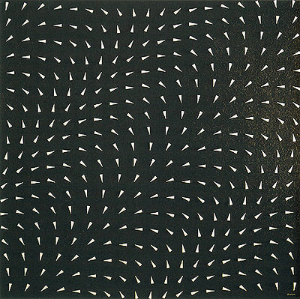Activity 5 - Concreção 8332
Figure 7 - Concreção 8332

In this artwork, Sacilotto brings the isosceles triangle repeated 361 times across the space of a black canvas, each row shifted millimetrically, with each row in a different direction.
In the book Sacilotto (2001), Enock Sacramento highlights that the visual impact of this painting, one of Sacilotto's most striking works, changes depending on the viewing angle. When seen head-on, the artwork can evoke images of fireworks frozen in the air or the orderly arrangement of iron filings in a magnetic field, even though Sacilotto had no intention of representing anything concrete. When the gaze focuses, brief impressions of black modules on the black background may appear, like shadows. When viewed at an angle, sideways, or even upside down, its 19 rows of pointed modules are revealed, both horizontally and vertically.
We invite the reader to explore the activity developed in GeoGebra. We recommend experimenting with the modification of the original isosceles triangle, altering the position of one of its vertices to create new configurations and reinterpretations.
Using the commands learned throughout this material, we propose that the reader develop their own reinterpretation inspired by the artwork Concreção 8332.